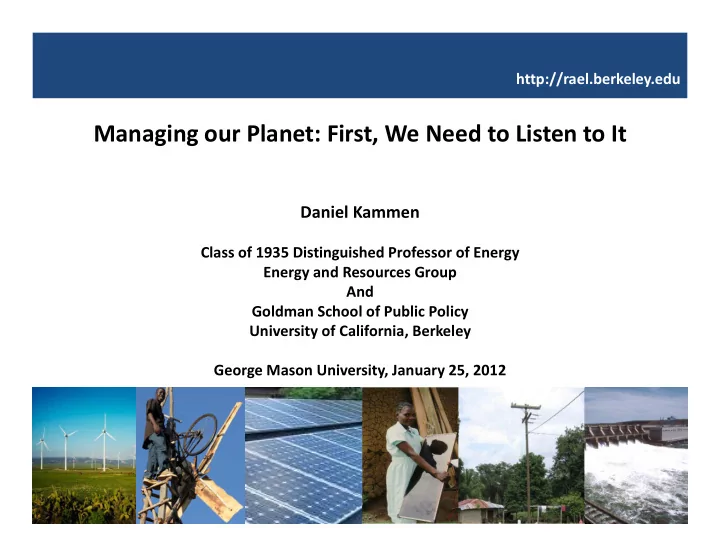

http://rael.berkeley.edu Managing our Planet: First, We Need to Listen to It Daniel Kammen Class of 1935 Distinguished Professor of Energy Energy and Resources Group And Goldman School of Public Policy University of California, Berkeley George Mason University, January 25, 2012
We Facing Two Energy Challenges The two crises are equally pressing Energy poverty Environmental Change We are failing to address either fast enough (or at all) rael.berkeley.edu UN General Assembly resolution 65/151
Illness Reduction Observed in Kenya (ARI = acute respiratory infection) , Source: Ezzati & Kammen, The Lancet, 2001 1.4B total DALYS: 10% of DALYS lost to ARI x 50% potential reduction This image cannot currently be displayed. Probability (ARI) All ARI ALRI, Lower respiratory Infections only Average Daily Exposure ( g / m 3 )
Example Unintended Consequence: Cooking and Utility Reform Household least cost means of cooking: (1990) [pre ‐ privatization of the utility] (2004) [post ‐ privatization] Monthly Cooking Cost: Dar es Salaam, Tanzania: 1990 and 2004 10,000 Monthly Cooking Cost 2004 2004 (1994 TSh/month) 8,000 2004 6,000 lowest cost option 1990 1990 1990 4,000 1990 2004 1990 2004 2,000 0 Charcoal Charcoal Electricity LPG Kerosene (improved) (unimproved) Data Source: Hosier, R.H. and W. Kipondya, Urban household energy use in Tanzania. Energy Policy, 1993. May: p. 454-473. (1990) Rebecca Ghanadan, PhD Candidate, Energy and Resources Group, University of California Berkeley, field research, (2004)
1 st IPCC Assessment (1990): FAR: unequivocal detection of FAR human impact not likely for a decade 2 nd (1995) SAR: balance of evidence suggests SAR discernible human influence 3 rd (2001) TAR: most of the warming in the last 50 TAR years is likely (>66%) due to human activities AR4 4 th (2007) AR4: most of the warming very likely (> 90%) due human activity 4 th (2007): warming will most strongly and quickly impact the global poor SRREN (2011): 80% clean by 2050 possible, if …
Energy Poverty: Opportunity to Act The United Nations Secretary General has declared rael.berkeley.edu UN General Assembly resolution 65/151
Global Greenhouse Gas Marginal Abatement Curve Gas plant CCS retrofit Abatement cost Coal CCS retrofit € per tCO 2 e Iron and steel CCS new build Low penetration wind 60 Coal CCS new build Plug ‐ in hybrid cars Power plant biomass co ‐ firing 50 Residential electronics Reduced intensive Degraded forest reforestation Residential agriculture Nuclear 40 appliances Pastureland afforestation conversion Retrofit residential HVAC High penetration wind 30 Degraded land restoration Tillage and residue mgmt Solar PV 2 nd gen. biofuels Solar CSP 20 Insulation retrofit (residential) Building efficiency Cars full hybrid new build 10 Waste recycling 0 5 10 15 20 25 30 35 38 Organic soil restoration ‐ 10 Abatement potential Geothermal ‐ 20 GtCO 2 e per year Grassland management Reduced pastureland conversion ‐ 30 Reduced slash and burn agriculture conversion ‐ 40 Small hydro 1 st generation biofuels ‐ 50 Rice management Efficiency improvements other industry ‐ 60 Electricity from landfill gas ‐ 70 Clinker substitution by fly ash Cropland nutrient management ‐ 80 Motor systems efficiency ‐ 90 Insulation retrofit (commercial) Lighting – switch incandescent to LED (residential) ‐ 100 7 Global GHG Abatement Cost Curve v2.0 (2010) : McKinsey & Company
Global Greenhouse Gas Marginal Abatement Curve: Mexico Low ‐ Carbon Study 8 J Johnson, et al., Low ‐ carbon study for Mexico (2010) : The World Bank
Energy Efficiency Training, Orinoco Christian Casillas (Energy and Resources Group PhD student)
Greenhouse Gas Marginal Abatement Curves: Communities of Orinoco & Marshall Point, Nicaragua 10 Casillas and Kammen (2010) “The energy ‐ poverty ‐ climate nexus,” Science , 330 , 1182 ‐ 1182
Tools for Sustainability Assessment 11
12
13
Greenhouse gas and sustainability calculators: http://coolclimate.berkeley.edu & http://www.coolcalifornia.org
Recommend
More recommend